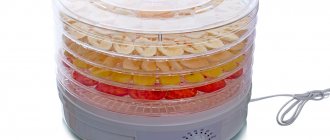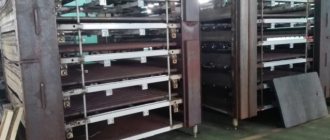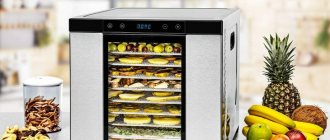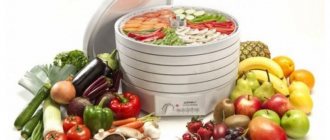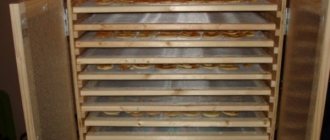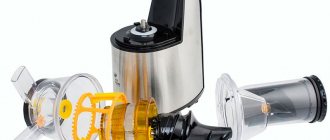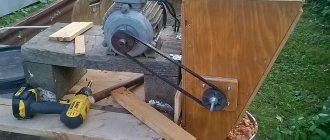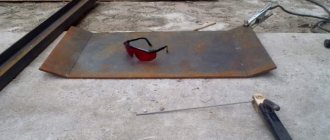12/21/2015 Category: Do it yourself Author: Natalya Ivantsova
Fruits are a source of pectins and vitamins, the consumption of which provides the body with essential nutrients. But fresh fruits are available only in the warm season. You can prepare them for the winter through a certain processing, which involves two options. Vegetables and fruits are canned or dried.
A fruit dryer is an excellent device that you can build with your own hands at minimal financial cost.
Today the second method is preferable. A fruit dryer is an excellent device that you can build with your own hands at minimal financial cost.
- Required tools and materials
- Step-by-step instructions for making a dryer for vegetables and fruits with your own hands
Regular
- Infrared device
- Solar design
Assembly options for solar dehydrators
Solar dehydrators are dryers that use solar energy to operate. They are good for drying herbs, fruits or vegetables, even fish. Such designs are more economical, however, they can be used effectively only in hot sunny weather. You can make a very simple design in the form of an ordinary box, or you can make a more “advanced” device equipped with additional equipment.
Simple solar dryer
To make a simple solar dryer for your summer cottage you will need a minimum of materials, tools and time. The assembly of the housing is carried out using a method similar to the manufacture of a dehydrator in the form of a homemade cabinet. The exception is that there is no need to make holes for fans and in the dryer door.
Small slots for ventilation are made in the upper and lower walls of the structure and are equipped with mosquito nets. Another difference is that the bottom surface must be longer than the top, thus achieving an angular position for the door. The drying box must be placed on a stand made of wooden blocks, made like a stool.
The box door must be made of transparent material: glass, plastic, plastic film. It is mounted to the top like a frame.
The box contains slats for baking sheets. Their number is determined by the size of the manufactured box. You should not leave a small distance between the pallets - this has a bad effect on the circulation of air masses.
In the end, all that remains is to select or make suitable pallets. After which you can place the homemade dehydrator in a well-lit place.
Device with collector
A solar dryer with a collector is a more labor-intensive version of the product. The drying box is designed almost the same as a simple dryer. But there are a number of significant differences. This dehydrator consists of 2 parts: an air heating zone (collector) and a food drying zone. The front of both areas should be covered with transparent material.
Holes should be made at the bottom of the heating zone for free air flow. An aluminum plate painted black should be installed on the inner wall of the collector. Air passing along this plate will heat up and flow through an additional hole into the lower part of the drying zone. As it rises, it picks up moisture and exits through the exhaust pipe to the outside.
For a dryer with a collector to work effectively, it must be moved so that the collector is constantly facing the sun. To avoid this, you can improve the dehydrator with additional collector devices on each side.
Modification with fan and thermostat
To make a solar dryer with a fan and thermostat, you should prepare the following materials:
- glass or plastic;
- plywood;
- corners, bars, slats;
- wheels with a diameter of 40-80 mm (for ease of moving the unit);
- aluminum sheet;
- small fan (diameter 120 mm, 12 V);
- thermostat;
- voltage stabilizer with KR142EN8B microcircuit;
- 12 V solar battery;
- mosquito net.
For ease of assembly, you should be guided by the drawing indicating the dimensions of the product parts, which is presented below.
The first step is to assemble the body of the product from beams and plywood and seal it. Then, wheels are mounted on the bottom of the dryer. With their help, the product will easily turn towards the sun. The back door of the dryer is made of transparent material (glass or plastic).
If you follow the dimensions suggested in the drawing, then 7 pallets can be installed in this dryer at a distance of 7 cm from each other. For this purpose, wooden slats are mounted in the body. It is appropriate to make pallets for such a design from mesh material and support slats.
A black painted aluminum sheet is installed on the manifold. A fan is mounted in the upper part of the box and, in accordance with the diagram, an electrical circuit is assembled from a fan, a solar battery, a voltage stabilizer and a thermostat.
When connecting the elements of the electrical circuit, you should be guided by the diagram below.
To increase the performance of the assembled solar-powered dehydrator, it must be placed so that the collector and battery are facing the sun's rays.
Do-it-yourself dehydrator for drying mushrooms
What is a dehydrator and what is it for? The meaning of the concept is already contained in its name. A dehydrator is a special device designed to remove excess moisture and is used for drying mushrooms , as well as other vegetables, seeds and fruits.
This product will be useful in the household and will become an indispensable assistant for avid mushroom pickers. During the drying process, all the beneficial properties of the mushrooms are preserved in full, the taste only becomes better, and their shelf life increases significantly. In this way, it is possible to extend the life of the harvest, especially if the year has been fruitful and you have stocked up on mushrooms for future use.
The new generation of dehydrators are quite different from the dryers our grandparents used to dry their mushroom crops.
The most important thing you need to pay attention to when buying a dehydrator, in addition to cost and functionality, is its technical characteristics and operating diagram. During operation, warm air is generated and blown over the product. The temperature is set by the user himself, based on which mode will be optimal for drying mushrooms.
Among the main distinguishing features of the dehydrator are the following:
- uniformity of drying (due to the fact that air flow at the required temperature is carried out not only vertically (bottom/top), but also from inside the structure);
- the ability to independently set the temperature level that is necessary for the optimal level of drying of mushrooms. The specified temperature must be maintained at any level of the structure;
- manufacturing the device from materials that are environmentally safe for health, subject to the recommended operating conditions.
Types of fruit dryers
Currently, the consumer can independently produce three types of dryers:
- electrical;
- infrared;
- devices “powered” by the sun.
In the first device, moisture from the fruit will evaporate by exposure to hot air, which will be forcibly heated by the built-in fan. Such devices delight with efficiency, reliability and long service life.
Infrared models' drying method resembles a process involving sunlight. Only the role of the source will be performed by a special heater that transfers thermal energy to the products. Moisture will be removed from the fruits, and they will retain their color and presentable appearance.
Solar dryers are devices in which fruits are dried using a natural method under the influence of sunlight.
Useful tips
- Vegetables and fruits should be cut into small and not very thick pieces.
- If you are using a fan dryer, you do not need to turn on the air flow right away. It is necessary that the slices lie in the dryer for 2-3 days.
- Temperature is the main criterion for the correct drying process. 40-50C is the optimal temperature at which the maximum vitamins and nutrients will remain in dried products. Therefore, some summer residents cover the internal surfaces of the dryer with thermal insulation material. This is especially true if the device is made from an old refrigerator.
- Shelves should only be mesh. It’s just that air must constantly circulate in the internal space.
As you can see, making a dryer for drying vegetables and fruits with your own hands is not so difficult. Mostly used building materials are used, so production costs are low.
Rules for using a homemade dryer
The rules for using a solar dryer boil down to the following aspects:
- To obtain dried fruits, they should be cut into small pieces, placed on trays and placed in a case.
- It is impossible to immediately influence them with a stream of air. Fruits and vegetables should lie in the device for 3-4 days, only after this time can the drying process begin.
- One of the necessary conditions for high-quality drying of fruits is the presence of a certain temperature regime in the structure. It should not be raised prematurely. To do this, the walls of the dryer are covered with heat-insulating material. The temperature level should be between 40°C-50°C and not exceed this figure. Otherwise, the vitamin content in fruits will be significantly reduced.
- The solar structure is installed at a slight angle so that the rays fall on the structure. To do this, the dryer is leaned against any suitable surface. Metal pipes can be attached to the side parts of the body, which will act as a support.
- It is recommended to use mesh material to make shelves so that air can circulate freely throughout the dryer. A mosquito net will do.
Assembling an infrared dryer
An infrared dryer is suitable for mushrooms, vegetables, nuts and fruits. It’s quite easy to make it yourself. To do this you will need the following materials:
- iron wire with a diameter of 5 to 8 mm;
- a cardboard box, for example, from a vacuum cleaner;
- aluminium foil;
- metal mesh;
- light bulb socket;
- awl;
- screwdriver;
- self-tapping screws;
- socket for a regular light bulb with fasteners;
- thermometer;
- infrared lamp;
- aluminum tape or glue.
The installation is created in the following sequence.
The insides of the box are covered with aluminum foil using tape or glue. Shelves are made from mesh according to the size of the box. On any wall near the bottom, make a hole for the supply wire and secure the cartridge with self-tapping screws. Screw in the infrared bulb. A thermometer is attached to any sidewall. Cut the wire into pieces that are approximately 5 mm longer than the width of the box. Punch holes in the sides for the rods for the shelving. They insert a wire into them and seal its protruding ends with tape on the outside. Stack the shelves.
As a result, after all the manipulations, you will get an installation similar to that shown in the photo below.
The lid can be the side parts of the box, or it can be made separately from the same cardboard. If you want to automate the design, you should use a temperature sensor. Under his control, the light will turn on automatically.
Also in the created design you can use an incandescent lamp (its sufficient power is 60 W) or a heating film used to create heated floors. In the latter case, at home, a piece of 50 by 100 cm with a power of 110 W is sufficient. In general, the length of the fragment is selected based on the box used.
When using film you will also need:
- insulation, for example, bitumen, used to create heated floors;
- a set consisting of 2 clamps, two eyelets and the same number of terminal rings, which is intended for connecting power to the film.
PVC tape is laid on top of the bitumen insulation. To connect the film, you will need to solder wires and contacts.
This dryer allows you to reach temperatures of almost 60 degrees. It can be rolled up and placed on the bottom of a box made using the previously indicated method.
Dryer option No. 2
Let's look at another option, how to make a mushroom dryer with your own hands over a gas stove. So let's get started:
- For work we will need aluminum corners of various lengths and a wire mesh.
- First, measure the dimensions of the slab in order to create a dryer that can later be placed on its surface.
- Use a drill or electric drill to drill holes in the corners so that they can be secured with bolts and nuts.
- Now it comes to the grid on which the mushrooms will be placed. Cut it according to the dimensions of the slab and the frame itself, with a margin.
Important! A mesh made of bandage, gauze or plastic will not work, as it is dangerous to hold such materials over a fire.
- In order to secure the mesh to the frame, use the same aluminum corner, but smaller in size. It should turn out so that the mesh is laid on the platform from the frame from below, and pressed against the top by an overlay plate.
- Also attach the plate to the frame using screws through the pre-drilled holes.
- The height above the fire should be determined independently, approximately 60-70 cm (just saw off the legs to the required length).
- Place the mushrooms, turn on the gas and that’s it, the process has begun.
Important! Never leave gas unattended.
General device design
It should be noted that today gardeners use three types of dryers, which are based on different drying principles.
- Using air flow movement. In principle, the structure of this device is a box, inside of which grids are laid one above the other, and chopped fruits or vegetables are placed on them. One or two holes are made on the side of the box into which fans are inserted. With their help, airflow occurs.
- Using the sun. This is a chamber in the form of a box, installed at an angle so that the sun's rays always fall on the pallets where fruits and vegetables are placed. The front part of the device is often covered with glass or mesh. Experts recommend not using a metal body in this type of dryer. It becomes very hot under the influence of sunlight and begins to emit a lot of thermal energy, which negatively affects the quality of dried fruits.
- Dryer with infrared heating element. In principle, this is all the same as the solar variety. Only instead of sun rays (free), ultraviolet rays are used here, which are emitted, for example, by a special film connected to a transformer. A very effective design that dries quickly and efficiently. But of all those described above, it is the most expensive. True, one of the advantages is the fact that the design of the dryer itself can be simplified to a minimum. There is no need for a drawer or chamber, you just need to install mesh shelves and direct the UV rays from the heating element onto them.
Use of air flow movement for drying
General structure of the dryer
The principle of operation of the dryer is the effect of increased air flow on crushed fruits. As a result, metabolic processes in the fruits are activated, moisture leaves, and they dry out faster. There are three types of dryers, each of which has its own device.
The design of a standard dryer consists of 4 main parts:
- fan;
- housings;
- tray for fruits and vegetables;
- electric motor.
The operation of a solar dryer is based on the penetration of rays through a transparent material and heating of a sheet mounted on the back wall. This contributes to an increase in the temperature inside the device, when the indicator can reach 50°C. Fruits and vegetables dry out when exposed to such conditions. Thanks to good ventilation, moisture is removed outside, which prevents the formation of mold on the fruit. A cold air flow penetrates from the bottom side of the structure, heats it up in the body and exits through the top hole.
This dryer consists of:
- wooden case;
- trays for crushed fruits;
- transparent polycarbonate cover.
The infrared dryer is a multifunctional, convenient device. It can be rolled up. This will make storing the device much easier. If necessary, it can also be easily transported. The potential of such a device is 58°C, which allows you to obtain high-quality dried fruits. This device will also successfully cope with the function of a heater.
The structural elements of such a dryer are as follows:
- infrared film;
- case from a box;
- transformer;
- wiring.
There may be doubts about the feasibility of making a dryer. After all, if the fruits are placed in an ordinary attic, after a certain period of time they will reach the required state. This option does not require effort or financial investment. But it also has a drawback. Vegetables and fruits in this case will attract insects. It is impossible to prevent this situation from occurring, since constant contact with air is necessary for the fruit to dry completely. Accordingly, they cannot be placed in sealed packaging.
Of course, you can treat fruits with a special compound so that insects lose interest in them. But the taste properties of the fruit change. In addition, after such processing, fruits retain chemical components in their structure, and they can no longer be called completely safe.
Important! A dryer is the most acceptable way to stockpile supplies to enrich your diet with vitamins for the winter.
What can you cook with a dehydrator?
Dried fruits. Do you like prunes, dried apricots, dried berries and pieces of fruit? A dehydrator is what you need! Homemade dried fruits are more natural, healthy and economical compared to store-bought ones (expensive and unknown how they are prepared).
Paste. The taste of fruit and berry marshmallows from the store is incomparable to the taste of homemade natural marshmallows prepared with your own hands. Treat yourself and your family with a simple, but tasty and healthy treat!
Eco-chips. With the help of a dehydrator, you can enjoy the only chips in the world that will bring nothing but goodness! Banana, orange, strawberry and any other fruit slices of your choice.
Raw food breads, kozinaki, sweets, cookies and cakes.
Healthy snacks are a reality! Of course, if you have a dehydrator at home. With it you can dry not only fruits and vegetables - even sweets such as candies, cookies and kozinaki can be easily obtained in a raw food version.
Crusts for raw food pizza, cake or pie.
To make pizza or pie, you don't have to bake the dough. You can dry it in a dehydrator at temperatures up to 40°C and get the basis for a raw food pizza or pie - all you have to do is put the filling on it according to your taste.
Fermentation of yoghurt and soy cheese.
With removable trays, the Dream Vitamin dehydrator can accommodate large jars of yogurt or soy cheese to speed up their fermentation.
Herbal preparations for storage.
A dehydrator is an ideal device for preparing herbs for tea or infusions. Fireweed, mint, lemon balm, lavender, chamomile and many other aromatic and healthy plants will be carefully dried and will retain their benefits and natural taste for you. And to make drying herbs even more convenient, the Dream Vitamin kit includes 9 sheets for bulk products.
Drying papier-mâché and other crafts made from plaster, dough or clay.
The dehydrator will be useful not only for lovers of tasty snacks, but also for handicrafts: with its help you can dry crafts made from clay, plaster, dough and papier-mâché.
A dehydrator is an indispensable technique in the arsenal of a raw foodist and anyone who cares about their health and strives to eat healthy. With a homemade dehydrator for fruits and vegetables, you will enjoy delicious and healthy delicacies: raw food breads and kozinaki, dried fruits, marshmallows, eco-fruit chips. The main features of dishes prepared in a dehydrator are natural taste, benefits, simplicity and economy.
As the most optimal model in terms of price/quality ratio, we recommend the Dream Vitamin DDV-10 horizontal dehydrator from RawMid.
This model can dry food at temperatures up to 40°C, has a built-in timer, and 10 removable steel trays. The device comes with 9 pallets for marshmallows and 9 grids for bulk products.
With this dehydrator, preparing your favorite dishes will be a pleasure!
Solar dehydrator with collector
A more complex version of the solar dryer (shown in the photo below) consists of two sections:
- air heating zone consisting of a collector;
- drying zones where products are placed.
The front parts of both zones are covered with transparent material, for example, glass, polycarbonate.
The collector is a box, the bottom of which is covered with a thin sheet of metal painted black. A heat insulator (mineral wool or sawdust) is placed under it to minimize heat loss. Air enters the heating zone through the ventilation holes. Then it goes up through the food shelves and out.
For the device to work effectively, it must be constantly kept with the collector directed towards the sun. If the collectors are installed on three sides, then there is no need for rotation, and such a drying unit will work all day. All cracks are sealed with sealant.
Safety rules for making a homemade dryer
When making a dryer, all frames should be fastened with self-tapping screws, and the joints of the frames should be filled with sealant. In addition, it is necessary to carefully insulate the wires when making electric dryers without using soldering.
And when using drying cabinets, it is strictly forbidden to allow insects to get inside the device. Also, before connecting the equipment to the network, you must check its housing and electrical cable for integrity!
Subscribe to our Social networks
How to make an electric fruit dryer with your own hands
A device operating from an electrical network has a number of characteristic features. The operating mode is as follows: moisture is removed by means of heated air masses penetrating 1 cm inside the fruit. At the same time, the fruit retains all its qualities and vitamins, which is why it will be stored for a long time. But before manufacturing such a unit, you will need to prepare tools and understand its structure.
Electric dryer device
Structurally presented devices have a body where shelves for fruits are located. Each shelf holds approximately 1 kg of food. In addition, the unit has a heating element. The top of the device is covered with a lid with slots. It ensures unhindered air movement inside the device.
What you need for work
Electric apparatus for drying fruits consist of the following parts:
- body (plywood sheets measuring 60 by 80 cm or an old refrigerator);
- mesh made of metal;
- shelves for arranging vegetables and fruits;
- a fan with a motor or two incandescent lamps with a power rating of 150 W;
- screws for fastening.
Accordingly, to make our own drying unit we will need the presented parts.
Making a Dryer: A Step-by-Step Guide
Step 1. If using sheets of plywood, the first step will be to connect them. And when preference is given to the refrigerator, you need to remove the compressor, freezer and remove the glass wool.
Step 2. You need to make holes at the top and bottom of the dryer for unhindered air movement.
Step 3. Make the bottom. The role of the bottom can be assigned to a grid with small cells. A grill grate can also fulfill this role.
Step 4. The interior of the dryer should be lined with insulating materials.
Step 5. Then slats are attached inside to arrange the pallets. They can be made from wooden beams or mosquito net edging.
Step 6. At the last stage, install the fan on the case and check the functionality of the device.
What you need to make your own dryer
To make a homemade dryer, we need the body of an old refrigerator and a fan heater (a heating element from an electric grill, a dryer from a washing machine, or a special heating fan). Also, we will need old shelving or, if there are none, a bunch of boards. with which we will later make the necessary shelves for our drying. Advice. Use old refrigerator grilles, increasing their width, because by removing the glass wool and the entire inner layer of the refrigerator, we increased its size inside.
Do-it-yourself dehydrator for meat and fish
A dryer for meat and fish can be easily made from a plastic container. For this you will need:
- fan;
- plastic container equipped with a lid;
- steel rods with a cross section of 5 mm or studs with threads, washers and nuts;
- pipe cut or coupling.
The entire process of making a dehydrator for drying fish, meat and drying other products from a plastic container is demonstrated in the video:
It’s easy to assemble a dehydrator for fish, meat, vegetables, fruits and other products from scrap materials: plywood, boxes, a refrigerator. Various working old fans are suitable for blowing. In each case, you will, of course, need to think over a way to secure them, but the economic costs will be reduced. In small installations, you can use a fan from a computer, having previously provided the required supply voltage. If you automate the dryer, then in terms of functionality it will be able to compete with factory analogues. When drying meat and fish, it is imperative to prevent flies from entering the interior of the installation so that they do not spoil the products.
DIY mushroom dryer
For long-term storage and storage of food products for future use, various methods of processing them are used - drying, drying, smoking, salting. Often processing processes involve air drying. Some products that contain a lot of water are heat-treated, that is, dried at a fairly high temperature in the oven (melons, apples, some fruits). Many other foods are dried in the wind or sun (fruit, fish, poultry, ham, salted meat). An excellent alternative to such methods is a do-it-yourself mushroom dryer, which can also be used for preparing other products. Let's look at how convenient this device is and how you can assemble it with your own hands.
How to prepare boxes
Place a fan heater in the lowest row so that the warm air moves upward. To do this, a hole is cut in the box with a diameter slightly smaller than the fan. It is necessary that it fits tightly in the hole made.
The resulting structure must be installed on the same box. This must be done so that the wire does not get pinched (it will be located freely in the lowest drawer), and there will be constant air access to the fan heater. You need to install another one on the box with the fan, and make holes in it for access to the power and temperature regulators.
Manufacturing of drying trays
Inside the cabinet, homemade nets are placed on the guides.
They are also assembled from wooden planks connected with construction angles.
Just don’t glue the pieces of wood together!
When heated, the glue will release toxic fumes. Therefore, only corners or a stapler.
It is better to choose a metal mesh made from food-grade stainless steel on which the products will be placed. It will not release any chemicals when heated.
Beekeepers filter honey through this. The only problem is to find it.
Many people advise not to bother and take the reinforcing material that goes under the plaster. It supposedly contains only fiberglass and nothing more.
However, do not forget that there is also a binding element - an epoxy compound. It is also not recommended to use a mosquito net.
It contains plastic and toxic paint. With such trays, after just a few years of abundant absorption of “healthy” dried fruits, oncology will definitely await you.
You shoot the mesh onto the bar with a stapler along the entire perimeter.
Such pallets are made in just a few hours. For the above cabinet sizes, the optimal number of nets inside is 4 pcs.
The dimensions of the mesh tray should be 5 cm narrower than the depth of the cabinet.
This is necessary so that warm air can circulate freely from both the back and front.
It is better to place the pallets themselves in such a way that the first is located close to the door, and the second to the back wall, etc.
With such a checkerboard layout, the warm flow will consistently blow tier after tier.
The tray is pushed in or placed on guide bars. They are made either wood or aluminum.
In this case, aluminum releases heat faster after heating. However, the question of its environmental friendliness and toxicity always remains open. Wood is still safer.
Expert recommendations
Using three strips of thin steel, the gables should be made. At the bottom of each strip it is necessary to make longitudinal bends that will not allow rain to penetrate inside. Such useful homemade products necessarily include a roof, which is made of two sheets of polycarbonate. The principle of operation of the device is ventilation; for this, a box should be installed. Air will penetrate through the mesh pan, removing moisture. Through the roof, where there are gable and side gaps, excess moisture will evaporate. To increase the intensity of traction, the back wall should be covered with black film.
How to make an infrared fruit dryer yourself
An infrared dryer is an alternative to electrical devices. They are quite similar in their method of operation. And fortunately, any consumer can make the presented device with his own hands at home. This does not require any special knowledge or skills. All you need to do is follow the instructions below.
What does an infrared dryer consist of?
The design of these devices includes a cable with a switch and plug, a 100 by 50 cm film intended for heated floors, as well as 2 terminals, a similar number of eyelets and clamps. Everything is extremely simple.
Required tools and materials
The materials described in the previous paragraph will definitely be needed to make your own dryer. But besides them, we need to prepare several tools to successfully complete the work, namely:
- soldering iron;
- bitumen and PVC insulation;
- metal block.
Step-by-step production of an infrared dryer
The process will not take much time and you will only need to follow a few simple steps.
Step 1. Support corners and walls must be trimmed so as to prevent their contact with the heater.
Step 2. Three bases for IR element holders should be cut out of cardboard.
Step 3. To direct the radiation to vegetables and fruits, you will need to use foil, which will serve as a reflector.
Step 4. At this stage, we cover the inside of the case with foil and connect the heaters to the transformer.
Step 5. Afterwards, you should assemble the entire system and check the device for functionality.
Advantages and disadvantages of such a dryer
Each type of dryer presented has its strengths and weaknesses. Simple designs require constant attention and participation from users. At night or in inclement weather, the pallets are moved indoors. The product has to be constantly mixed by hand, and the degree of its readiness is determined “by eye” or “by tooth”.
But any improvement of the product will provide the same functionality as industrial designs. In closed-type dryers with forced air flow and heating, barometers are installed to indicate the temperature and humidity inside the drying chamber.
Some craftsmen use homemade vibrators, for example, from old washing machine drain pumps. This device allows you to shake the contents of the pallets from time to time, mixing it. An indispensable condition is the presence in the design of a cable or cord that connects all the pallets with the vibrator.
If we take into account the positive aspects of self-made designs, the percentage of quality dominance will be significantly higher than that of factory-made dryers.
Do-it-yourself electric dryer for fruits and vegetables
To do this, you need to make an electric dryer body, buy a fan, a heating element, a temperature sensor (thermostat), a time relay, and two chimney draft regulators.
Fan
For our purposes, household smoke exhausters for boilers are best suited.
Smoke exhausters for domestic boilers
Their distinctive feature is that they can pass through air at temperatures up to 150°C without damaging the electric motor. An ordinary axial fan is not suitable for these purposes. It is not able to work at a temperature of 50°C for a long time. The diameter of smoke exhausters starts from 150 mm. An electric heating element with an open spiral must be placed in the pipe coming from the smoke exhauster.
Electric heating element for dryer
For maximum heat extraction, the heating element must have an open coil. The power is calculated based on the permissible rated power for the house and is equal to 3 kW minus the power of the smoke exhaust fan and household appliances. If this norm is exceeded, the automation will work and turn off the lights in the house.
Electric heater with open coil
When choosing an electric heater, consider its dimensions. It must fit into a pipe that is connected to a smoke exhauster or fan that supplies air to the drying chamber.
Smooth thermostat
Thermostats with smooth temperature control from 0 to 300°C are a standard part of all household electric furnaces. It must be connected in series to the electrical circuit with heating elements and a fan. When the required temperature is reached, it will automatically turn off the heating and fan.
Household thermostat
You can use a thermocouple from ovens.
Where to buy a thermostat? There are several purchasing options:
It is quite possible to purchase a thermostat at a flea market.
Time relay
In order to fully automate a homemade dryer, you need to buy an electronic two-channel time relay with weekly programming.
There are many options for designing and programming time relays and everyone can choose the right one for themselves.
By connecting a fan and heating element to the time relay, you can adjust its operation experimentally. To do this, you need to set the turn-on time of the heating element and fan.
Chimney draft regulator
Draft regulators are installed in stainless steel chimneys. This automatic device consists of a precisely fitted valve on an axle. To ensure that it is always closed or open, a small weight is installed on one side.
Install these two valves in the inlet and outlet openings of the dryer. When the fan is turned off, they will close the inlet and outlet of warm air under the weight of the load.
Traction regulator
The use of these valves will allow you to automate air intake and supply without the use of actuators and expensive controllers.
For particularly advanced handymen, we recommend purchasing a programmable controller. This equipment is more complex, but it allows you to automate all drying processes, connecting humidity sensors, temperature sensors, motors, gate valves and other actuators. They are widely used for lumber drying kilns.
Options for DIY electric dryers
Homemade electric dryers differ from each other only in the materials from which they are made. In the selection of available materials, the creativity of do-it-yourselfers knows no bounds. Here are a few examples of amateur electric dryers that have proven themselves to work.
Dryer from an old refrigerator
Old Soviet refrigerators such as “Saratov” or “ZIL” usually live out their lives in dachas. Nothing lasts forever, they eventually fail and the best option would be to make an electric fruit dryer out of them with your own hands.
- As a component of the dryer, you only need the refrigerator body. Therefore, the compressor, refrigeration radiator and freezer should be carefully removed. It is important not to damage the housing to maintain tightness.
- When heated, plastic sheathing and thermal insulation will be a source of harmful substances and unpleasant odors. It is necessary to remove them, leaving only the rubber band as a door seal.
- To organize airflow, install a household fan in place of the compressor. Install heating elements in the lower part of the refrigerator, where air flows from the fan will pass.
- The shelves are made of metal mesh stretched over a frame of wooden slats. The air flow from the fan should pass freely through the mesh cells. The size of the shelves is larger than the original ones from the refrigerator by the thickness of the heat-insulating layer.
- To install shelves, secure wooden slats or aluminum and stainless steel corners to the side walls of the refrigerator. The distance between them should create the possibility of good airflow of dried vegetables and fruits, while making maximum use of the space of the refrigerator body.
- Exhaust ventilation is placed on the top wall. A section of sewer pipe is inserted into the hole, in which the exhaust fan is located.
- It is important to ensure the housing is sealed. In addition to the door seal, the fastening of the door to the body should be equipped with additional clamping loops.
- Covering the inner surface of the body with aluminum foil will significantly increase the service life of the electric dryer.
Electric dryer from a homemade cabinet
A wooden cabinet is used as a body for the dryer. Since kitchen furniture is made mainly from fiberboard and chipboard, it is not recommended to use this industrial option for drying vegetables and fruits. These composite materials contain harmful substances such as adhesives. It is impossible to guarantee protection using thermal insulation.
The option of making it from birch, oak and similar wood will create the necessary conditions for obtaining a high-quality dried product.
- We decide on the size of the cabinet. We make blanks from boards. The box is fastened with self-tapping screws.
- A hinged door is attached to the finished box. To create an airtight interior, it must be tightly closed, for example, with latches, as shown in the image:
- To prevent heat from being transferred to the wooden walls, the entire internal surface, including the door, is lined with reflective material in the form of foil. It is absolutely harmless when exposed to elevated temperatures. It is better to fasten the foil using self-tapping screws with a large head.
- Support strips are installed inside the wooden frame covered with foil. They can be made from wood or as shown in the image from aluminum angle.
- To make shelves for vegetables and fruits, it is better to use a mesh made of food-grade stainless steel. Other options, for example, reinforcing mesh for plaster or mosquito net, contain materials that, at elevated temperatures, release harmful substances that accumulate on dried products. The mesh is placed on a frame made of wooden planks connected to each other by building corners.
The size of the shelf along the depth of the case should guarantee a gap (about 5 cm). By staggering the shelves as shown in the image,
the air circulation process improves - it passes freely along both (back and front) walls. - The choice of heating elements is quite wide: from conventional heating elements to industrial floor-mounted household fan heaters. The best option is when air supply and heating are combined in one device in accordance with all the conditions of electrical safety rules.
In a wooden case, problems arise in installing heating elements. In addition to choosing a stand (in no case asbestos), you need to secure the heating tubes well. - For a specific type of vegetable, fruit or berry, there is its own optimal drying mode. Therefore, temperature adjustment is mandatory. You can purchase a temperature sensor and thermostat without any problems at a specialized electronics store. You can connect the thermostat via a power supply, and connect the temperature sensor to a digital thermometer.
- Humid air can be removed through a plastic pipe inserted into a hole in the upper wall of the wooden case. The temperature of the exiting air flow will no longer be so high as to heat the plastic until it releases harmful substances.
- The dehydration process in a wooden case requires periodically changing the shelves in order to obtain uniform drying of all products. Those located closer to the heat source lose more moisture than shelves on the upper tiers.
How to make the simplest version of an electric dryer
Not everyone has the ability to work with wood or it is not possible to find food-grade stainless steel mesh. In this case, there is a dryer option, which is called for the lazy. The following materials and components are used in production:
- household fan heater;
- fruit storage boxes;
- stretch film.
The order of work is as follows.
- A seat for the fan heater is made in one of the boxes. It is securely fixed in it.
It is placed on top of the same box in order to organize free space for air intake. - The required number of boxes is built in a similar height as the first two. The column of boxes is wrapped in 6–8 layers of stretch film (except for the bottom one). Next, cut the film with a knife along the borders of contact between the boxes.
- Organize access (you can cut out windows in the box) to the regulators of the fan heater operating modes. After loading the prepared boxes, the required mode is set and a simple do-it-yourself fruit and vegetable dryer performs its assigned function. To combat insects, cover the top drawer with gauze.
It is important to choose the right plastic from which the boxes are made. In some hot countries, where temperatures are below 40 °C, a special polymer material is used that allows fruits to be stored at high temperatures for a long time without harming them. For the above design of the electric dryer, these are the boxes that are used.
How to assemble a structure
The required number of boxes are placed on the constructed structure. Each box is a drying container. If the cells at the bottom of the box are large, then you can cover the bottom with a mosquito net with medium cells. The assembled pyramid must be wrapped with stretch film - at least 7 layers for packaging film and at least 10 for food film. This ensures overall sealing of the structure. It is necessary to wrap all the boxes except the bottom one (which is intended for air flow).
After the process of sealing the dryer is completed, it is necessary to make sure that the boxes can be used individually. To do this, use scissors or a sharp knife to carefully cut the film at the junction of the boxes with each other. To keep the film tightly, it must be glued to the box along the bottom edge with adhesive tape.
The mode suitable for drying is set on the fan heater as follows: the temperature is set to the maximum, and the power of the device is set to the average value. In this mode, the fan heater will not overheat too much, and, accordingly, will not turn off spontaneously. The optimal temperature for drying is +40-45 degrees.
That's it, the dryer is ready for use. The drying process in such a device takes from 8 to 12 hours.
What types of dryers for vegetables and fruits are there?
There are several main parameters by which dryers differ from each other:
Airflow type.
Dryers come with vertical and horizontal airflow. Vertical dryers have a round shape, the fan is located at the bottom and directs the air flow upward. Such dryers, as a rule, are cheaper, but have a number of significant disadvantages: uneven drying of products on different levels, less capacity, inconvenient rearrangement of trays, mixing of odors of products from different shelves. Horizontal dehydrators are a little more expensive, but are distinguished by uniform drying, greater capacity, and convenient rearrangement of trays. These dryer models have a rectangular shape; the fan is located on the back wall and evenly blows food on all shelves, so that odors do not mix.
Choose horizontal dehydrators - they are characterized by more uniform drying and ease of use.
Capacity.
Among horizontal dehydrators there are models with 6, 7, 10 and even 20 trays - for any needs. The most popular are dryers with 7 or 10 trays - this capacity is sufficient for home use even in large families or for drying crops. One of the most compact models is the Dream Vitamin DDV-07 dehydrator with 7 trays. And for large volumes of products, there are super-capacity dryers with 20 trays. A 10-tray dehydrator is the golden mean, which is suitable for almost any need - city residents, summer residents, gardeners, large families with children.
Materials.
When choosing a dehydrator, you should pay attention to the material of the trays. To protect products as much as possible from the absorption of toxic substances, we do not recommend models with trays made of ordinary plastic
Dryers with steel racks, such as the Dream Vitamin DDV-10, are preferable. If the durability of the case is an important factor for you, then you can choose a model with a stainless steel case, for example, Dream Pro.
Give preference to dehydrators with steel trays - they are safer and more durable.
Time and temperature settings.
Modern dryers for vegetables and fruits allow you to set the drying time, after which the device will turn off automatically
Another important function is setting the drying temperature. For raw foodists, models with the ability to set the temperature no higher than 40°C are suitable.
This function is provided, for example, in the Dream Vitamin dehydrator. This means that with it you can naturally preserve vegetables, fruits, berries, herbs, and mushrooms for many years, while preserving the nutrients of the food - vitamins, enzymes and microelements.
Plus, the Dream Vitamin control panel contains useful tips for drying different foods.
Infrared dehydrator
A good dryer for herbs, nuts, mushrooms and fruits can be made using an infrared light bulb. For work you need the following materials and tools:
- wire with a diameter of 5-8 mm;
- small cardboard box;
- foil;
- metal grid;
- lamp holder with fasteners;
- thermometer;
- 60 W infrared lamp;
- screwdriver, knife and awl;
- screws, tape.
The inside of the box is covered with foil and mesh shelves are prepared according to its size. On one of the walls below, a hole is made for the wire and a socket with an infrared lamp is fixed there. A thermometer is attached to one of the inner walls of the box.
Mesh tray holders are made from pieces of wire. To do this, you need to pierce the walls of the box, thread pieces of wire and secure their ends with tape.
You can use a thermometer to monitor the temperature inside the device. It is recommended to dry plant products at a temperature of 40-50 degrees. If the temperature inside the dryer exceeds the norm, you can turn off the light bulb for a while or leave the drawer lid ajar. This product can be made more convenient to use by installing temperature sensors. Which will automatically turn off the lamp when it overheats.
Homemade dehydrator from an old refrigerator
To make a dryer at home, the main factor is the availability of suitable material for the body of the unit. An unnecessary refrigerator is well suited for these purposes.
Preparatory activities
The body of an old refrigerator is a good option for a homemade electric dryer. Spacious and stable, it will get a second life as the external frame of home drying equipment.
To make a dehydrator, you first need to get rid of unnecessary parts: freezer, compressor and radiator
Dismantling should be carried out very carefully so as not to spill the working substance of the refrigerator. The refrigerant can be used, for example, freon, ammonia, SF6
These substances are unsafe for the human body.
Dryer assembly
After preparatory measures have been carried out, a fan of suitable size is installed in the place where the compressor was installed. A device with a diameter of about 120-200 cm and a power of 18 W is suitable. It can be purchased specially or removed from the old exhaust system. A special feature of the installation is the fact that the fan must work to force air masses inside the dehydrator.
In the upper part of the refrigerator you need to cut a hole for a pipe with a diameter of 10 cm. This can be done using a tool available at home, for example, a crown or a jigsaw. This hole is designed as an outlet for moist air. On the roof of the refrigerator, a piece of metal pipe (with the appropriate diameter) or aluminum corrugation is installed into it. A sufficient pipe length is 2-3 m.
For faster drying, you can install a small hood at the upper end of the pipe. The top of the duct should be protected from insects using a mosquito net or gauze folded in several layers.
In order to be able to load products into the future dehydrator for drying, wooden slats are attached to the sides of the refrigeration chamber body. Pallets will be placed on them. The distance between the slats is chosen to be 10-20 cm. This is enough to place various vegetables, fruits, mushrooms and herbs, both chopped and some as a whole. If there is a need to dry larger pieces, then simply remove the extra trays from the refrigerator.
It should be noted that when using heating elements, it will be necessary to install an additional fan to speed up the exhaust. If these methods of accelerating drying are not required, then you can get by with a simple fan.
If desired, a homemade dryer can be improved with the help of temperature sensors. Also, with the proper skill, you can equip the equipment with a timer and other automated means for your convenience.
Pallet production
Trays for the dehydrator should be selected or made according to the size of the refrigerator, so that there is a gap of 2 cm between their edges and the door. The same gap should be provided between the trays and the rear wall of the case. This is necessary for complete airflow of products at all levels.
DIY drying cabinet
If you don’t have unnecessary equipment at home with a suitable housing, you can make a drying cabinet yourself. For work you will need the following materials:
- plywood sheets;
- slats;
- corners;
- foil;
- electric heating device;
- regular and fan heater;
- self-tapping screws
The first step is to install the frame of the cabinet, then it is sheathed with plywood or other wood on all sides except the door. You can pre-drill holes in the rear wall for mounting fans. The door is made separately from the same materials and is attached to the body using hinges. Previously, numerous holes with a diameter of 5-10 mm are drilled on the surface of the door.
The inside of the cabinet is lined with aluminum foil and wooden slats for pallets are attached to its side walls.
Baking trays for fruits and vegetables are selected in the same way as when making a refrigerator dryer. Their dimensions should not interfere with the free circulation of air inside the dehydrator.
Both fans are mounted on the rear wall of the cabinet: a fan heater in the lower part, and a regular fan in the upper part.
Parallel connection of devices is allowed, thanks to which they will operate from one switch. You can also equip your drying cabinet with lights that will serve as visual indicators of its operation.
Dryer option No. 1
The design of the dryer and the principle of its operation are quite simple. To perform such a dryer, you should:
- Make a frame in the form of a parallelepiped from slats.
- Place it on edge (matchbox gray side down).
- Cover both sides, as well as the bottom and top edges with solid material (oilcloth, roofing felt, cardboard, plywood). Moreover, the top edge will be a lid on hinges, like the lid of a piano.
- Tighten the end edges with gauze or fine mesh.
- Stretch wires along the side walls inside the dryer to hang food.
- Inside, on one side, directly next to the gauze, install a tabletop room fan, and pass its current-carrying wire through the gauze, without leaving a free passage in it, and bring it out to the outlet.
Device Application
Food products should be placed on metal hooks and suspended from taut wires. After a complete check and all flies have been expelled, the lid is closed and the fan is turned on.
Important! The intense air flow created by the fan ensures fairly fast drying of food in compliance with sanitary requirements.
As a rule, the duration of drying in a mushroom dryer is determined experimentally. It will depend on the humidity of the surrounding air, its temperature, as well as on the size of the dried products, their moisture content and the required final moisture content.
Helpful Tips:
- The dimensions of the dryer can be arbitrary and depend on the amount of product to be dried.
- In order to reduce energy consumption, it is recommended to use fans that have several operating modes, which will make it possible to change the ventilation mode in the dryer.
- You can install such a dryer almost anywhere: on the veranda, balcony, under a canopy or even on the street.
- It is better to load food in the evening or early in the morning, when there are no flies.
- It is better to first hang larger parts of food closer to the fan, and then they can be swapped.
Important! Many years of operation of dryers of this type made it possible to study their operation under different conditions. Remarkable results were obtained in drying fruits, churchkhela, low potatoes, dill, parsley, salted chickens and ducks, boiled sausages, hams, and dried mushrooms.
